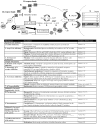Cholinergic deficiency hypothesis in delirium: a synthesis of current evidence
- PMID: 18693233
- PMCID: PMC2917793
- DOI: 10.1093/gerona/63.7.764
Cholinergic deficiency hypothesis in delirium: a synthesis of current evidence
Abstract
Deficits in cholinergic function have been postulated to cause delirium and cognitive decline. This review examines current understanding of the cholinergic deficiency hypothesis in delirium by synthesizing evidence on potential pathophysiological pathways. Acetylcholine synthesis involves various precursors, enzymes, and receptors, and dysfunction in these components can lead to delirium. Insults to the brain, like ischemia and immunological stressors, can precipitously alter acetylcholine levels. Imbalances between cholinergic and other neurotransmitter pathways may result in delirium. Furthermore, genetic, enzymatic, and immunological overlaps exist between delirium and dementia related to the cholinergic pathway. Important areas for future research include identifying biomarkers, determining genetic contributions, and evaluating response to cholinergic drugs in delirium. Understanding how the cholinergic pathway relates to delirium may yield innovative approaches in the diagnosis, prevention, and treatment of this common, costly, and morbid condition.
Figures




References
-
- Inouye SK. Delirium in older persons. N Engl J Med. 2006;354:1157–1165. - PubMed
-
- Inouye SK, Bogardus ST, Jr, Charpentier PA, et al. A multicomponent intervention to prevent delirium in hospitalized older patients. N Engl J Med. 1999;340:669–676. - PubMed
-
- Pitkala KH, Laurila JV, Strandberg TE, Tilvis RS. Multicomponent geriatric intervention for elderly inpatients with delirium: a randomized, controlled trial. J Gerontol A Biol Sci Med Sci. 2006;61:176–181. - PubMed
-
- Bellelli G, Speciale S, Barisione E, Trabucchi M. Delirium subtypes and 1-year mortality among elderly patients discharged from a post-acute rehabilitation facility. J Gerontol A Biol Sci Med Sci. 2007;62:1182–1183. - PubMed

